Fraud? Secret 2021 Membership Data Now Reveal PRSA’s Disinformation
In December 2021, PRSA only had 15,652 regular members, not "more than 30,000 members" as falsely promoted on PRSA's social media. Fraud?
The Public Relations Society of America’s so-called campaign against “disinformation” needs a reality check against PRSA’s own disinformation practices, when it comes to reporting just how many people are — or are not — on PRSA’s membership roster.
Not only might PRSA, Inc., be falsifying data on its federal IRS tax return (2021 filing, image below) by officially misstating membership, but PRSA’s sponsors and advertisers who pay large sums of money — into the thousands or tens of thousands — to access PRSA’s member database for marketing purposes may be getting ripped off royally by being significantly overcharged on promoting their brands to PRSA “members” who simply do not exist.

Questions abound of potential PRSA fraud, resulting from serious omissions and manipulations of newly revealed membership data.
PRSA’s December 16, 2021 National Board of Directors monthly meeting packet is now in the public domain via my open-records request to the St. Lucie County, Florida, former government employer of Joseph Abreu, who was PRSA Secretary in 2021 and now sits at the helm of PRSA’s legally noncompliant practices as 2024 PRSA Chair.
Fifty-one (51) pages composed this secret PRSA meeting packet, which included a detailed report of then-current 2021 PRSA membership data.
The astounding insights contained in this previously concealed packet reveal just how inaccurately PRSA reported — and misrepresented — its membership data in its publicly published 2021 “Year in Review” annual report.
Now, two-and-a-half years later, bad news doesn’t age well. PRSA leadership never intended for anyone to see this data outside their own little group.
The “Year in Review” data vastly differ from dire statistics reported only to 2021 PRSA National Board members (below) in December 2021, under a veil of “confidentiality.”

As then-Secretary of PRSA in 2021, Joseph Abreu’s responsibilities are detailed in this excerpt from the 2021 Board orientation packet — a separate document:

The implications for PRSA’s Governance integrity, tied to potentially false accountings of membership data, are huge.
It was Mr. Abreu’s specific responsibility to be sure PRSA’s 2021 membership data was reported to voting Assembly delegates in compliance with New York State Not-for-Profit Corporation law, which requires full accounting of how many members the association has, along with year-over-year comparison data.
In other words, Mr. Abreu (or someone in PRSA leadership) was not only legally required to disclose PRSA’s official 2021 membership tally at the 2021 Assembly, but they also were legally required to disclose PRSA’s 2020 membership tally at this same 2021 meeting, for purposes of comparison, so that Assembly voting delegates could know for the record if PRSA membership was healthy and gaining (or at least remaining flat), or, if membership was on the decline to indicate a financially unhealthy / at-risk organization.
Breaking News: “Member associations” actually do require members.
Only proper free flow of information can allow voting delegates to cast their votes on PRSA governance issues in a properly informed, fiduciary manner.
But PRSA National leaders have been absolutely obstructionist to fiduciary responsibility, for many years now.
As such, keeping members and voting delegates painted into a corner of utter cluelessness has stood as a key aim by Mr. Abreu, many other PRSA National Board leaders, and PRSA executive staff, the latter of whom continue cashing in, accordingly.
Mr. Abreu opted out of his own legal obligation to disclose membership numbers in 2021, by punting his responsibilities to a PRSSA student, a “Ms. Meltzer,” who, to her own credit, only disclosed how many student members there were, as it was not her job to report how many PRSA professional members there were. I’m sure she would have been denied the data anyway even if she’d asked Mr. Abreu for it:

Mr. Abreu’s 2021 Assembly minutes documented for the record that neither he, nor 2021 PRSA Chair Michelle Olson, nor CEO Linda Thomas Brooks followed New York law to reveal PRSA’s official membership at the prescribed annual meeting.
Any audio-recording taken of the 2021 Assembly meeting was presumably — by order of PRSA’s written policy (below) — destroyed, so as not to provide any additional record for purposes of accountability later:

Not only did Mr. Abreu’s reporting omission outright fail to comply with state law, but PRSA chapters were therefore provided no way to reconcile if the number of voting delegates during that Assembly annual meeting was compliant with PRSA bylaws (one voting delegate per 100 members).
Members therefore could not validate whether (or not) chapters with low membership rosters — or that even had gone completely dormant — qualified for the number of voting delegates granted by Headquarters and Mr. Abreu.
For an organization that postures publicly via its Code of Ethics about the virtues of honesty, disclosure and free flow of information to aid stakeholder decision-making in a democratic society, PRSA’s own honesty, disclosure, and information-flow practices are shameful.
Or rather, sham-ful.
Let’s go through PRSA’s membership-data irregularities, point by point.
In December 2021, then-PRSA Chair Michelle Olson, PRSA CEO Linda Thomas Brooks, and PRSA Secretary Joseph Abreu reported the following membership data in the public-facing “2021 PRSA Year in Review” report, published in December 2021 some two months AFTER the October 16, 2021, annual meeting (so, this digitally printed annual report was of no use to inform delegates before or during the 2021 annual meeting… meaning, the delegates were voting blind of any legally compliant data in October 2021).
This December 2021 report claimed 18,364 “members,” with a highlight – denoted with asterisk – of 3,741 “new members,” but with no counter-balancing data included of how many members PRSA also had lost that year for appropriate context:
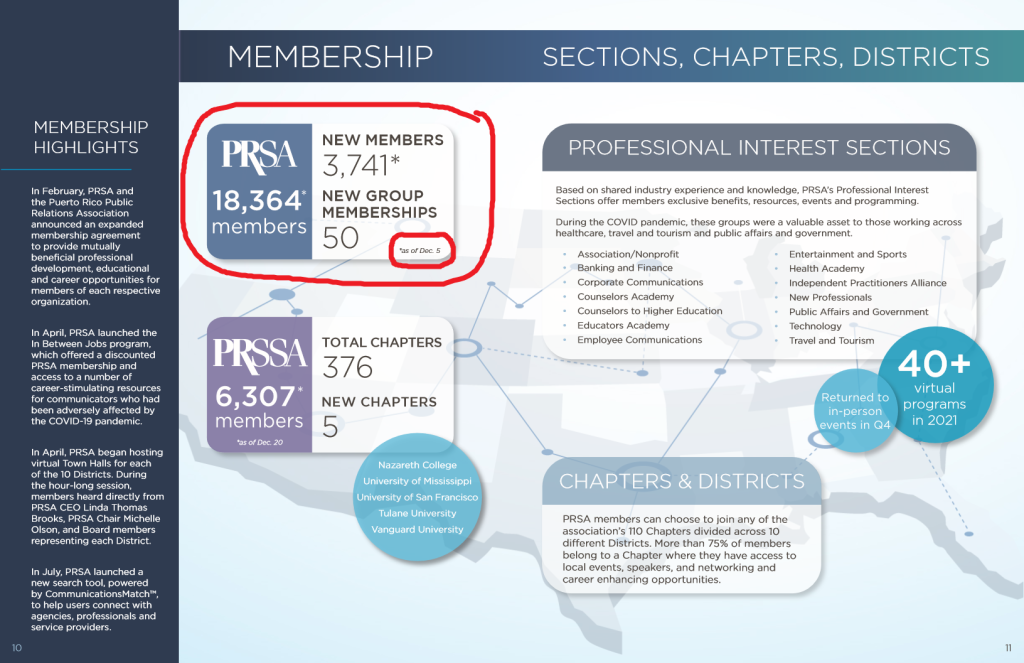
PRSA’s separate, secret December 2021 board packet with membership-data charts and graphs (shown further below) tells a different story than what’s depicted above.
Dues-paying members weren’t allowed to see the detailed information provided below, however, which was never included in PRSA’s published “2021 Year in Review” report.
For starters, PRSA has “regular members” (otherwise known as “full members”) who pay normal dues, and then, it has a universal bucket of “members” in which they dump other segments of membership, like “associate members” at various levels – most of whom are transitioning PRSSA student graduates who pay only a fraction of normal dues. (PRSA also has lost thousands of PRSSA student members in recent years, by even its own questionable accounting).
It also should be noted that even though the below membership categories vary widely in level of dues paid, PRSA allows all of these people in every category to serve as voting delegates and to run for PRSA’s National Board.
PRSA’s 2021 Board Orientation Packet included this break-down of how membership levels and dues were then being accounted for:
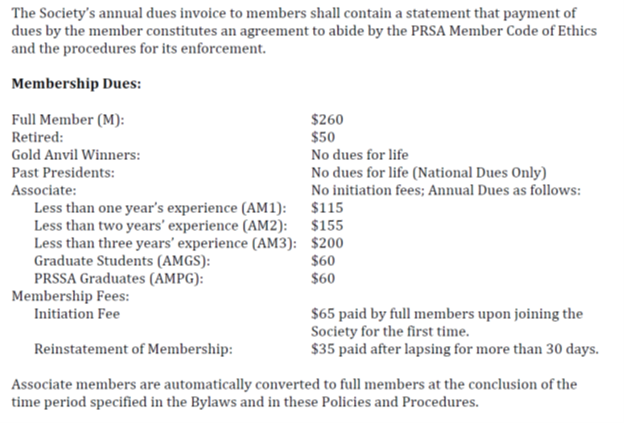
Sidebar: It’s interesting how this above orientation packet excerpt mentions “procedures” for “enforcement’ of PRSA’s Code of Ethics, but meanwhile, PRSA’s Code of Ethics website clearly states its so-called ethics code is not enforced. Just another example of how PRSA leverages ambiguity to confuse people about what the rules are, just as it leverages misleading data.
PRSA’s “regular members” as documented in the December 2021 secret PRSA Board packet only reflected 15,652 people paying full, annual dues.
This downfall from prior years in 2020 and 2019 also was documented in the secret Board report but was never even mentioned in the “Year in Review” public report — much less the October 2021 annual meeting. It shows that the “regular members” tally declined within only three years by nearly 3,000 members.
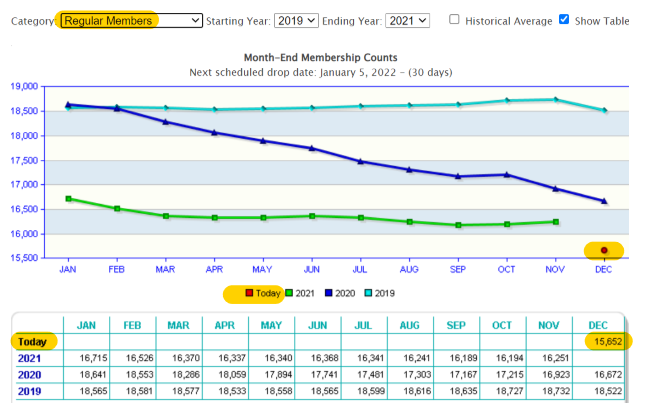
What that late-breaking December 2021 data point tells me is that PRSA leadership likely held back this large segment of member drops on purpose, until after the “Year in Review” document published, for the express purpose of keeping it out of the public-facing annual report, so that no one had to be accountable for the losses.
Bear in mind that during Ms. Olson’s 2021 PRSA chairmanship, she (and CEO Linda Thomas Brooks) allowed the then-PRSA Twitter handle falsely to highlight in its profile that PRSA had “more than 30,000 members.”
That’s nearly twice as many members as PRSA actually had, on any level. If that’s not “disinformation,” then what is?
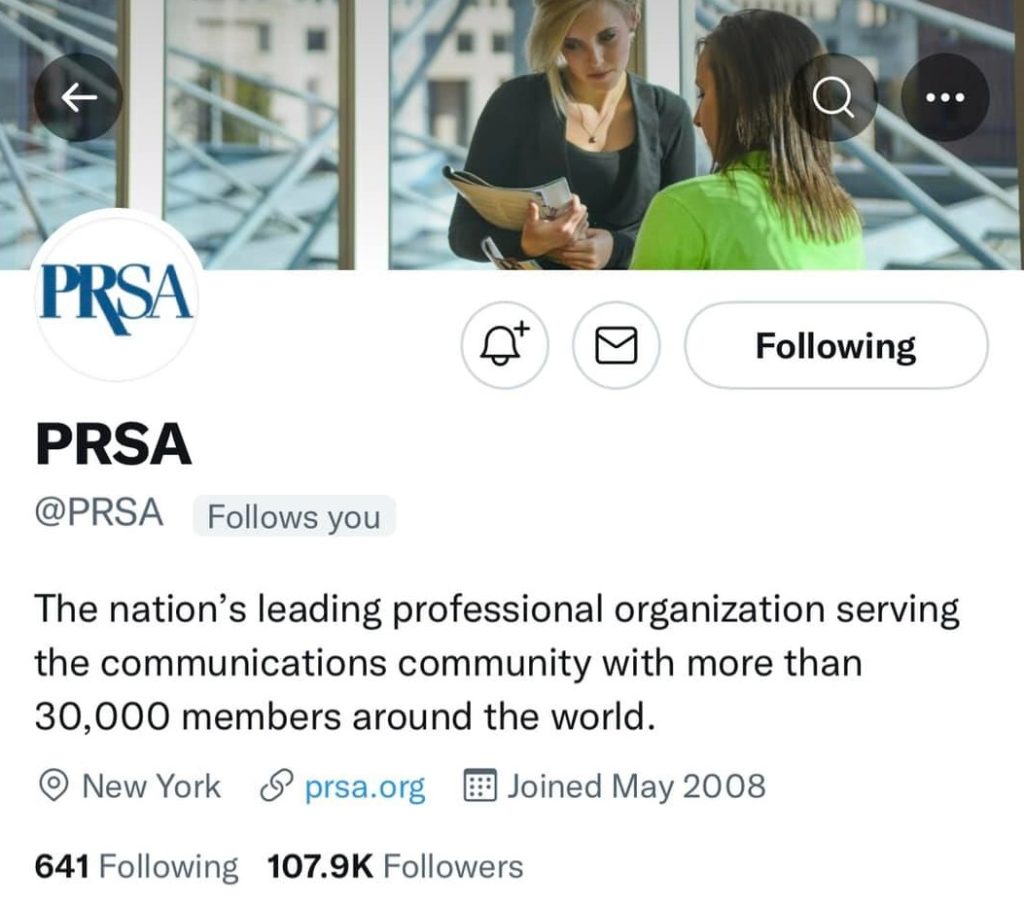
This tweet below documents that I was protesting even back then (December 2021) what I knew were PRSA’s falsehoods about how many members it had:
PRSA’s “associate members” subset, as only documented in the PRSA Board’s secret report, also showed dismal decline, with a two-year dive from 2,507 in January 2019 to 1,466 in December 2021:
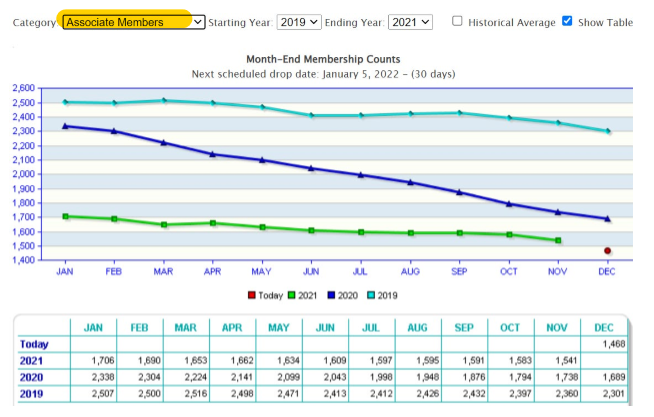
Also hidden from any public reporting, Ms. Olson, Ms. Thomas Brooks, Mr. Abreu, and their PRSA Board clearly made it their business that members would not be allowed to know that a large number of colleagues — 1,187 — who dropped membership were only registered as “drops” in December 2021 AFTER the “Year in Review” report was already published online.
There’s a term for that sleight-of-hand, and it’s called “data reporting manipulation.”
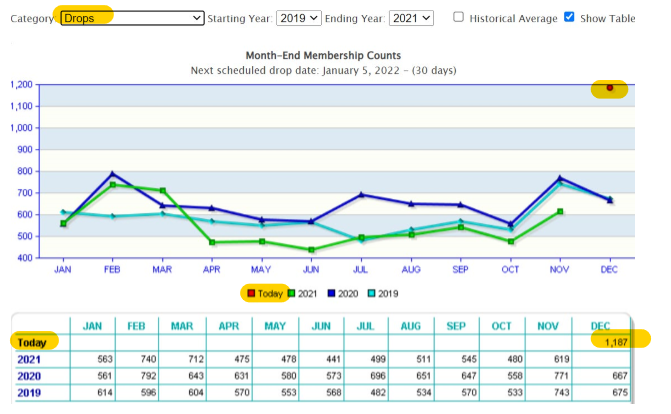
If you add up the numbers from the “2021” row in PRSA’s secret “Drops” report, along with the 1,187 dropped members documented in December 2021 alone (marked in the row labeled “Today” under the “Dec” column), you get another jaw-dropper (speaking of “drops”):
… A grand total of PRSA’s 7,250 “drops” in 2021… nearly TWICE the number of “new members” as were trumpeted in the “Year in Review” brochure as some big accomplishment.
For all of Ms. Olson’s, Ms. Thomas Brooks’, and Mr. Abreu’s public reporting of the 3,741 “new members” – for no other outcome than to mislead the PR industry that PRSA was ostensibly experiencing some kind of major membership upswing… or even a surge – what they also hid away from view was PRSA’s “Year One Retention Rate” data.
These abysmal numbers show that of those 3,741 “new members,” it was likely that some 60% of them would be lost by PRSA after only one year – if this historical trend was any indication:
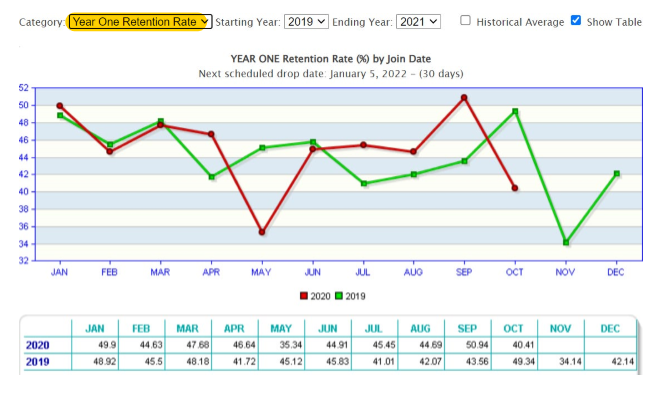
Ms. Olson pled her case in her “Year in Review” report back in December 2021 that “complex” times were “forcing us” to become “creative storytellers.”
PR 101: “Creative storytelling” is a poor — and, unethical — euphemism for all-out lying.
Also, lying was never “forced” on you during your PRSA chairmanship, Ms. Olson.
It was a choice. Your choice, to be exact.
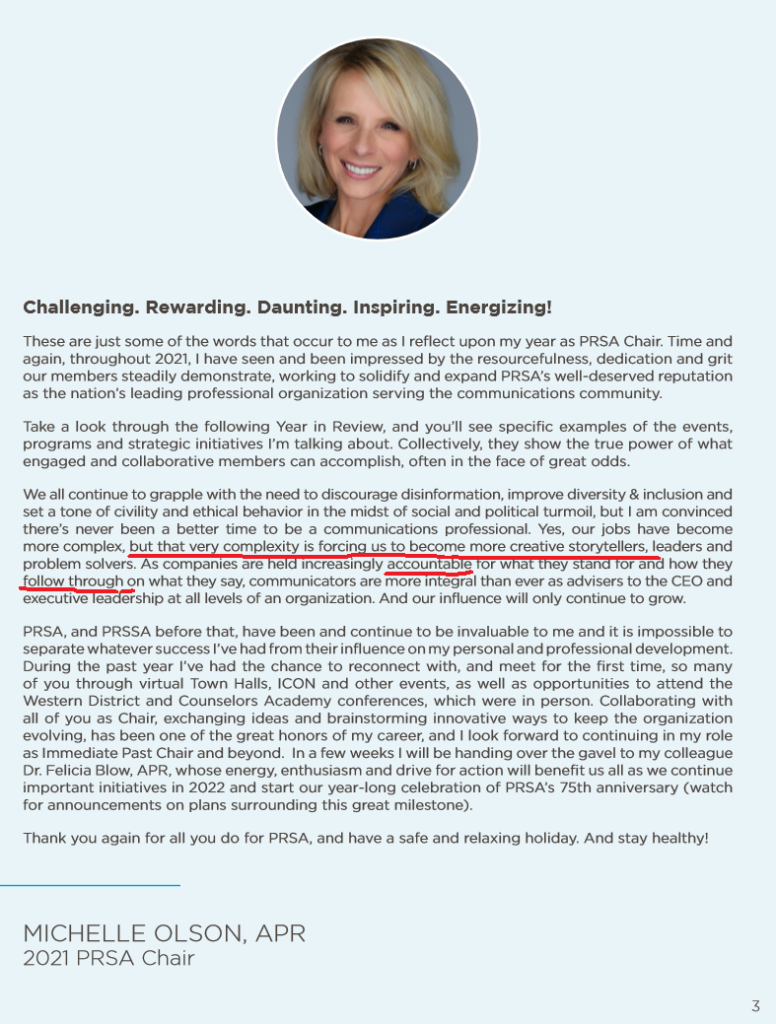
At the end of Ms. Olson’s catastrophic 2021 chairmanship, PRSA had lost $725,978 in member dollars on her watch.
But that factoid was only belatedly reported nearly a year later in November 2022 to the U.S. Internal Revenue Service, quite on purpose by CFO Philip Bonaventura… far too late for Ms. Olson herself to be held “accountable”:
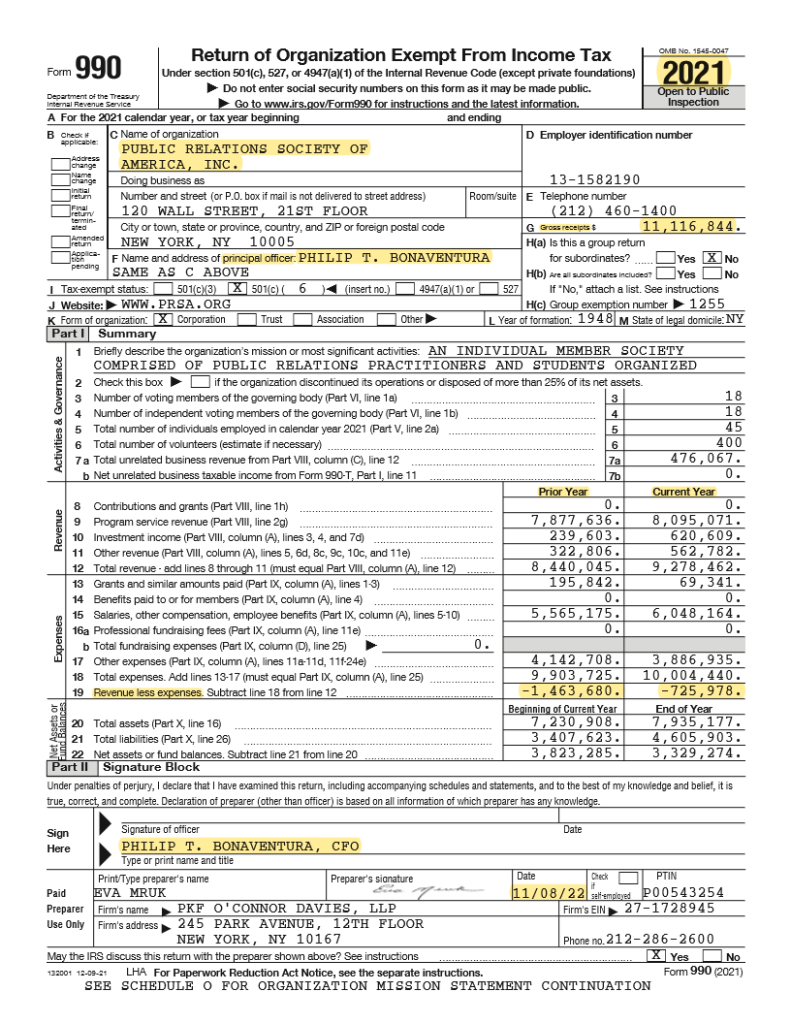
The question now stands:
Just how bad are PRSA’s REAL membership numbers today, in mid-2024?
If you’re relying on PRSA’s publicly reported data — such that it even exists, particularly now that Joseph Abreu has been rewarded by PRSA for his prior legal noncompliance as Secretary (and — lest we forget — “Grievance Panel Chair”) in 2021 by being made 2024 PRSA National Chair — then you’re on a fool’s errand in search of the truth.
For his part, now-Chair Abreu unwittingly exposed PRSA’s own level of membership desperation, by releasing just last week, in June 2024, this video of himself, below.
In it, Mr. Abreu dangled a rather strange carrot of implied motivation to PRSA chapters…
… that they could win a “prize” of getting to meet Mr. Abreu or Ms. Thomas Brooks (although it’s unclear who Mr. Abreu was marketing as 2nd Prize), if chapter members invest their own volunteer time to recruit unwitting PR practitioners in their local markets to fork over money in PRSA membership dues, so that — I’m led to believe — PRSA can mislead them, too:
Mr. Abreu’s little contest is monikered as “Game On!” — but it merits the question of whether PRSA is already facing a “Game Over!” reality.
As evidenced for years now, it appears PRSA will do practically anything – regardless of ethics code non-compliance for “honesty,” “accuracy,” “disclosure,” and “free flow of information,” as well as legal noncompliance with New York State law – to keep its own members and the industry purposely uninformed, misled, and confused.
That’s not the kind of “accountable” organization most competent PR practitioners care to spend their hard-earned dollars in affiliation with, and it’s certainly not one that most ethical employers care to support, either.
As a reminder to the world, Mr. Abreu works in his PR day job for a Florida taxpayer-funded entity himself.
https://www.leeclerk.org/Home/Components/News/News/1155/18?arch=1&npage=2
In Q1 2021, Mr. Abreu was working for the St. Lucie County, Florida, Court Clerk; then, he changed jobs and for the remainder of the year, to present-day, has worked for Lee County, Florida, Court Clerk. Both are government agencies.
So, every single time Mr. Abreu diverts his taxpayer-funded salary paid time on the workplace clock to PRSA disinformation strategies or tactics — or any other PRSA activities, for that matter (like kicking out whistleblowers from PRSA membership via kangaroo courts that he personally oversees) — it would seem to be a very real and valid concern about potential misuse of Florida taxpayer funds.
Back to my original question:
Do these PRSA membership reporting omissions and failures constitute fraud?
As food for thought, the Public Company Accounting Oversight Board documents these insights about conditions that create fraud:
“Three conditions generally are present when fraud occurs. First, management or other employees have an incentive or are under pressure, which provides a reason to commit fraud. Second, circumstances exist—for example, the absence of controls, ineffective controls, or the ability of management to override controls—that provide an opportunity for a fraud to be perpetrated. Third, those involved are able to rationalize committing a fraudulent act. Some individuals possess an attitude, character, or set of ethical values that allow them to knowingly and intentionally commit a dishonest act. However, even otherwise honest individuals can commit fraud in an environment that imposes sufficient pressure on them. The greater the incentive or pressure, the more likely an individual will be able to rationalize the acceptability of committing fraud.“
Based on these criteria, the fraud question is more than fair to ask of PRSA.
Members should demand answers here. I think many have tried, but PRSA’s Disinformation & Retaliation Machine casts quite a wide wake, particularly when PRSA staff and volunteer leaders lie to members’ faces — literally.
It’s not just a concerning issue for PRSA members and locally based chapter boards themselves to ponder.
As previously mentioned, any company / PR industry vendor that has paid PRSA, Inc., serious money these past years in good faith as a “sponsor” – under promises by PRSA that sponsors would reach X many dues-paying member eyeballs to promote their businesses to what PRSA certifies as qualified prospects – may need to contact their own legal counsel.
Given PRSA’s obvious data inconsistencies, perhaps sponsors should launch their own investigation into whether or not their company has been a victim of PRSA fraud by vastly overpaying PRSA on possibly false, multi-year assurances of questionable deliverables.
After all, it arguably would be fraudulent for PRSA to promise sponsors exposure to a particular number of members (like, you know… 30,000?!) that PRSA Headquarters well-knew did not even remotely exist… yet knowingly charged fees to sponsors anyway in accordance with a wildly false metric.
Perhaps this is the reason why PRSA’s real membership data points have been kept under such tight lock-and-key as a closely guarded secret for years now.
Back in July 2020 when I was still a PRSA member — before Mr. Abreu led a team of ethically compromised individuals to kick me out — I asked PRSA’s then-VP of Member Services on the MyPRSA “Open Forum” intranet message board, “How many members does PRSA have?“

It seemed like a very straightforward question for a dues-paying member to ask.
As I disclosed in my posting, I was trying to use a valid metric to compare just how PRSA was performing on its so-called “diversity and inclusion” program in membership recruitment / retention.
But instead of simply giving me a straight-up, real-time number, PRSA staffer Jay Starr refused:

While refusing to provide any real-time information to me as requested, Mr. Starr claimed that membership numbers would only be reported at the Assembly annual meeting, which, due to the pandemic, was put off until December 2020 as a “virtual” meeting.
But of course, at that 2020 Assembly, the meeting minutes later reflected membership data weren’t reported there, either, only that “membership was down” — which was a legally noncompliant “report” by then-Chair Garland Stansell, a well-documented member of PRSA’s cabal (a.k.a., “the gang who couldn’t shoot straight”):

So… back to this question for PRSA’s third-party sponsors:
Have CEO Linda Thomas Brooks and/or CFO Philip Bonaventura been pushing sponsors to pay for PRSA deliverables that both executives knew PRSA couldn’t provide due to known membership losses?
As much as PRSA’s dues revenue has fallen, sponsorship revenue streams have only gained in criticality to keep PRSA propped up like “Weekend at Bernie’s,” particularly in light of the PRSA Board’s approval of inexplicably large compensation packages sucking down member treasure like Drain-o for the likes of Ms. Thomas Brooks and Mr. Bonaventura… such as these figures in 2021.
Even Mr. Starr was being paid astronomically for services rendered like deflecting members’ valid questions.
Follow the money:

Here in my own backyard where I live and reside (Greater Knoxville, Tennessee), it’s further unfortunate that PRSA, via its chapter network, leverages awards bestowed to leaders of other third-party organizations who obviously have no knowledge of PRSA, Inc.’s corruption, for little other reason than for PRSA to siphon off credibility from those third-party orgs to garner a halo-effect to PRSA’s own rotten brand.
Personally, as a University of Tennessee alumna myself (and one who has donated many tens of thousands of dollars to UT over some 30 years and also was recognized as UT’s 1994 “Public Relations Student of the Year” and its 2013 “Public Relations Alumna of the Year”), it’s nauseating to see this bastardization of brand.
Similarly, it’s been devastating to me both personally and professionally to see PRSA’s documented dishonesty so up-close and, also, to be on the receiving end of its legally noncompliant retaliation.
There’s clearly nothing I can do about other people’s choices, despite my best efforts to help colleagues be informed.
Stay tuned to this blog for more revelations about newly uncovered, secret PRSA documents and correspondences from past years that reveal a very different reality from what PRSA has chosen to communicate and promote publicly, in disservice to PRSA members and the entire PR industry.
